KickSat Nanosatellite Mission
Non-EO
Mission complete
Technology and Research
Quick facts
Overview
| Mission type | Non-EO |
| Mission status | Mission complete |
| Launch date | 18 Apr 2014 |
| End of life date | 14 May 2014 |
KickSat Nanosatellite Mission
KickSat is a technology demonstration mission designed to demonstrate the deployment and operation of 104 Sprite “ChipSats” (3.2 x 3.2 cm femtosatellites with a thickness of a few millimeter) developed at Cornell University in Ithaca, N.Y., USA. The ChipSats will have an orbital lifetime of only a few days. ChipSats like the Sprites represent a new space technology that could enable new kinds of science and exploration missions, as well as lower the cost of access to space.
The KickSat project was designed and developed at Cornell University in 2011 with the goal of advancing the core technologies needed to enable low-cost ChipSat missions. Over the past two years, the Sprite ChipSat, a CubeSat-based deployer for the Sprite, and a SDR (Software-Defined Radio) ground station have been developed. The hardware designs, code, and documentation for all of these systems are being released under open-source licenses where possible. 1)
Much of the funding, that has made the KickSat project possible, was raised through the crowd-funding website Kickstarter. Over 300 individual backers pledged individual amounts from $25 to $10,000 in exchange for rewards ranging from having their names silk-screened onto articles of flight hardware, to being able to trigger the deployment of the Sprites along with the ground control team. In a particularly interesting foreshadowing of the possibilities for hobbyist space missions, 26 individuals pledged $1,000 in exchange for a development kit to write flight code for their own ChipSat. In total, nearly $75,000 was raised between October and December 2011.
The main goal of the mission, as stated by Zachary Manchester, a graduate student at Cornell, is to bring down the huge cost of spaceflight, allowing anyone from a curious high school student or basement tinkerer to a professional scientist to explore what has until now been the exclusive realm of governments and large companies. 2) 3) 4)
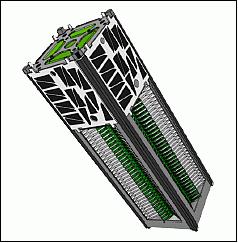
Spacecraft
KickSat is a 3U CubeSat configuration of size 10 cm x 10 cm x 34 cm with a mass of ~5.5 kg. The bus is based on the flight-proven PhoneSat 2.0 CubeSat developed at NASA/ARC (Ames Research Center) and is being built using primarily COTS components to provide power, communication, command and data handling, and attitude determination and control functions. A 1U space of the CubeSat is reserved for the avionics bus providing electrical power, active attitude control, command and control systems and communications for telemetry downlink and command uplink.
The remaining 2 CubeSat units are dedicated to the deployment mechanism that holds and secures the Sprites during launch and in orbit, using a lid. The deployment mechanism can hold up to 200 Sprites and uses a spring-loaded pusher, activated by a nichrome burn wire system to deploy all the Sprites. The prototype KickSat mission launching on the CRS-3 (Cargo Resupply Services-3) mission of SpaceX carries 104 Sprites. 5)
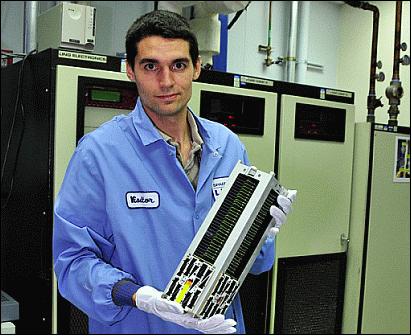
Sprite ChipSat
The Sprite concept makes use of modern, low-cost, low-power integrated circuits to create a general purpose “spacecraft bus” for chip-scale sensors. It includes Spectrolab TASC (Triangular Advanced Solar Cell) devices, a Texas Instruments CC430 microcontroller and radio SoC (System-on-Chip), a Honeywell HMC5883L 3-axis magnetometer, and an InvenSense ITG-3200 3-axis MEMS gyro, as well as associated passive components, on a printed circuit board measuring 3.5 cm x 3.5 cm with a mass of 5 gram (Figure 3).

The CC430 SoC is the core of the Sprite, providing all computing and communication capabilities. It combines an MSP430 microcontroller, which is clocked at 8 MHz and provides 4 kB of RAM and 32 kB of flash memory, with a very flexible CC1101 UHF transceiver capable of output powers up to 10 mW and data rates up to 500 kbit/s. Both the MSP430 and CC1101 have flight heritage on CubeSat missions. An Arduino-based development environment, known as Energia, has been ported to the CC430 to facilitate rapid code development and prototyping.
The Sprite’s antenna is a half-wave V-dipole, chosen for its isotropic gain pattern, easy tuning, and 50 ohm characteristic impedance, which eliminates the need for a matching network or balun circuit. The antenna is made of nitinol, a nickel-titanium alloy commonly referred to as “shape-memory alloy” or “memory metal,” which can be deformed to a tremendous degree and still return to its original shape. Nitinol was chosen so that the antenna could be coiled within the small footprint of the Sprite PCB (Printed Circuit Board) and still return to its intended geometry upon deployment.
The components on the Sprite were chosen with the goal of minimizing size and maximizing functionality within the available power budget. The solar cells deliver up to 60 mA of current at 2.2 volts directly to the electronics with no energy storage or power conditioning. The maximum current consumption of the Sprite is ~35 mA, so there is considerable margin. Several lithium-ion and lithium-polymer batteries were investigated that fit the size, mass, and power constraints of the Sprite, but it was determined that none could survive the low temperatures encountered during eclipse. Therefore, the Sprites can operate only in sunlight and will be completely unpowered in the eclipse phase of the orbit.
Sprite communication link: Perhaps the most difficult engineering challenge associated with the KickSat project is closing the communication link from orbiting Sprites to the ground stations. The Sprite’s transmitter is limited to about 10 mW of output power. A lack of closed-loop attitude control means a low-gain antenna with an omnidirectional gain pattern is required. Additionally, due to licensing constraints, the Sprites must efficiently share limited RF bandwidth. Closing link over several hundred kilometers with all of these constraints is a formidable challenge, but thanks to advances in consumer electronics, it turns out to be possible with relatively inexpensive hardware.
To overcome low SNR, matched filtering, which is the optimal linear filter for maximizing SNR (Signal-to-Noise Ratio), is used. The basic idea is to substitute each data bit with a long, specially chosen string of bits known as a PRN (Pseudo-Random Number) code that is agreed upon by the transmitter and receiver a priori. In this context, the bits making up the PRN code are commonly referred to as “chips” to differentiate them from the data bits. Rather than attempting to lock onto the carrier and demodulate the chips individually, the receiver instead looks for the entire PRN code by cross-correlating the incoming signal against the known code at each time step.
Aside from improving SNR, matched filtering also makes possible CDMA (Code Division Multiple Access. By assigning each Sprite a different PRN, the receiver can “tune” to a particular spacecraft’s signal by correlating against its unique code. This allows all the Sprites on a particular mission to share the same allocated frequency, simplifying licensing and eliminating the need for clock synchronization that would otherwise be required for the Sprites to alternate transmitting on the same frequency.
The signals of the Sprites released on this prototype flight will be tracked by a worldwide community of amateur radio operators. Monitoring the satellites also provides data on how the electronics on the Sprites respond to the harsh radiation environment in LEO (Low Earth Orbit). The mission uses the 437.240 MHz frequency (UHF). Each Sprite has a unique pair of PRN codes that it encodes its transmissions with, allowing a receiver to tell the Sprites apart,this is known as CDMA.
The Sprites will remain in orbit for several days or some weeks at most, strongly depending on atmospheric conditions.
Sprite Deployer
The Sprite deployer has been designed for simplicity and robustness while minimizing attitude disturbances on the spacecraft during deployment. The deployer contains 104 Sprites stacked in four columns in a 2-by-2 arrangement. Each Sprite is housed in an individual slot and constrained by a carbon fiber rod that runs the length of the column, passing through a hole in the corner of every Sprite (Figure 4). The nitinol wire antennas on the Sprites are coiled in such a way that they act as springs, pushing the Sprites out of their slots.
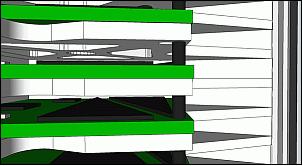
All four carbon fiber rods are attached to a single plate at the end of the deployer that is actuated by a compressed spring and held in place by a locking mechanism, shown in Figure 5. Deployment is triggered by a nichrome burn wire, which unlocks the mechanism, allowing the spring to pull the four rods out. The Sprites’ antennas then push them from the deployer housing, as shown in Figure 10, with an estimated ΔV of 5-10 cm/s.
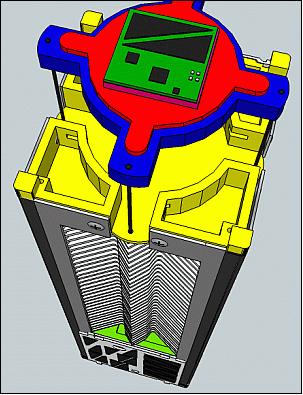
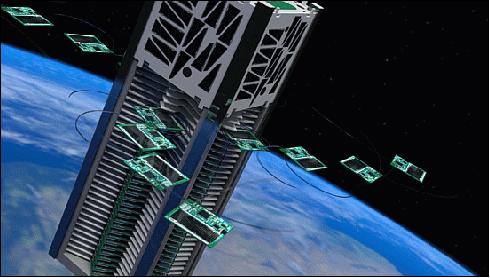
Launch
The KickSat 3U CubeSat is part of the secondary payloads on the Dragon cargo capsule resupply space transport mission to the ISS, the CRS-3 (Cargo Resupply Services-3) Falcon-9v.1.1 mission launched on April 18, 2014 (19:25:22 UTC) of SpaceX. The launch site was Cape Canaveral, FL. 7) 8)
Orbit: Near-circular orbit, ISS altitude of ~350-400 km, inclination =51.6°.
Secondary payloads: The secondary payloads (4 nanosatellites and 1 CubeSat) were contained in four P-PODs (Poly Picosatellite Orbital Deployers) and installed on the second stage of the Falcon 9 launcher. These secondary payloads were not being delivered to the ISS, but released from their P-PODs following the separation of the Dragon capsule from the second stage (~10.5 minutes after liftoff). The insertion orbit of the secondary payloads was at an altitude of ~325 km with an inclination of ~51.6º. 9)
The secondary payloads were part of the fifth installment of NASA's ELaNa (Educational Launch of Nanosatellite) mission. Over 120 students have been involved in the design, development and construction of all the CubeSats that were flown as auxiliary payloads on the SpaceX-3 cargo resupply mission. 10)
• KickSat, a 3U CubeSat of Cornell University, N.Y., USA. KickSat will carry and attempt to deploy about 250 femtosatellites into LEO (Low Earth Orbit).
• All-Star/THEIA, a 3U CubeSat of COSGC (Colorado Space Grant Consortium).
• SporeSat, a 3U CubeSat (~5.5 kg) developed through a partnership between NASA/ARC (Ames Research Center) and the Department of Agricultural and Biological Engineering at Purdue University. SporeSat will be used to conduct scientific experiments to gain a deeper knowledge of the mechanisms of plant cell gravity sensing.
• TSAT (TestSat-Lite), a 2U CubeSat developed at Taylor University of Upland, Indiana. The objective is to perform measurements of the temperature and density of the plasma in the near-Earth space environment.
• PhoneSat-2.5, a technology 1U CubeSat of NASA/ARC to continue technology demonstrations of the PhoneSat CubeSat series.
Deployment of KickSat
Upon release from the P-POD, KickSat will power up and start a countdown timer. At 30 minutes, the bus UHF radio antenna will be deployed, then at 45 minutes the bus radio will begin transmitting a beacon signal. During the first few passes, ground station operators at Cornell will establish communication and perform checkouts of the spacecraft. Over the next three to four days, the attitude control system in the bus will be used to point KickSat’s minor axis of inertia (long axis) at the sun, and then spin the spacecraft up to 10-15 rpm about the sun vector, ensuring attitude stability during the deployment sequence.
Once a stable sun-pointing attitude has been established, all systems have been checked out, and KickSat is in view of a ground station, a signal from the ground will trigger a nichrome burn wire to unlock the deployer. The deployer’s spring mechanism will then release the Sprites as free-flying spacecraft. The deployment sequence is intended to release the Sprites in a sun-pointing major-axis spin, which is dynamically stable. While there are no strict pointing requirements, the goal of this spin stabilization is to keep the Sprites’ solar panels pointed largely at the sun for the short mission lifetime and to minimize nutation, which would otherwise introduce attitude-dependent fluctuations in power.
Upon being exposed to sunlight, the Sprites will immediately be powered on and will begin taking sensor measurements and transmitting telemetry. Cornell will operate the primary ground station in Ithaca, New York, however amateur radio operators are being encouraged to set up their ground stations based on the published reference design. The primary criterion for mission success is the reception of data packets from the Sprites.

Due to their extremely low ballistic coefficient, the Sprites are expected to remain in orbit for only a few days before reentering and burning up in the atmosphere, alleviating debris concerns. Figure 8 shows altitude vs. time plots for bounding maximum and minimum, as well as average drag cases using the MSIS atmospheric model.
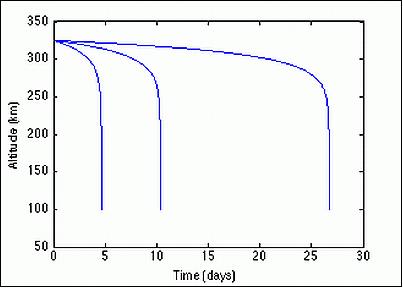
In line with other CubeSat missions, the KickSat nanosatellite is expected to remain in orbit for a few months before it too reenters. It may serve as a test bed for further communication and attitude control experiments during that time.
KickSat Mission Status
• KickSat reentered the atmosphere and burned up in the atmosphere on May 14, 2014 . Unfortunately, the project was not able to command the Sprite deployment in time. 12)
• The 104 Sprite satellites were to have been released on 4 May 2014. However, the automatic timer that was to release the satellites was reset by the onboard “watchdog” microcontroller on 30 April 2014, probably due to a high dose of radiation (it appears the reset happened some time in the morning of April 30). One consequence of the watchdog reset on KickSat is that the spacecraft's master clock was reset, thus also setting the deployment countdown for KickSat back to 16 days. That would put the deployment some time in the morning of May 16. — However, KickSat itself re-entered, as predicted, on 14 May 2014. 13)
Ground Station Receiver
With the goal of enabling as many people as possible to participate in the KickSat project, a reference design for a low-cost and portable Sprite receiving station has been developed. The hardware consists of a hand-held Yagi antenna, a low-noise amplifier (LNA), a low-cost USB radio receiver dongle (commonly known as a DVB-T or RTL dongle), and a PC running the GNU Radio software (Figure 9).
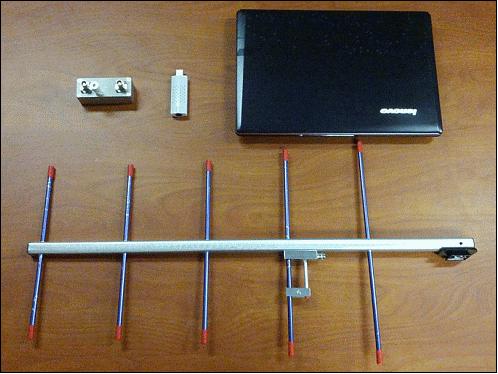
References
1) Zachary Manchester, Mason Peck, Andrew Filo, “KickSat: A Crowd-Funded Mission To Demonstrate The World’s Smallest Spacecraft,” Proceedings of the 27th AIAA/USU Conference, Small Satellite Constellations, Logan, Utah, USA, Aug. 10-15, 2013, paper: SSC13-IX-5, URL: http://digitalcommons.usu.edu/cgi/viewcontent.cgi?article=2976&context=smallsat
2) Zachary Manchester, “KickSat — Your personal spacecraft in space,” URL: https://www.kickstarter.com/projects/zacinaction/kicksat-your-personal-spacecraft-in-space
3) http://kicksat.wordpress.com/
4) M. J. Johnson, Z. R. Manchester, M. A. Peck, “KickSat.org - an open source ChipSat dispenser and citizen space exploration proof of concept mission,” 4th European CubeSat Symposium, Brussels, Belgium, January 2012, URL of abstract: http://kicksat.files.wordpress.com/2012/12/20101028r_kicksat-org-anopensourcechipsatdispenserandcitizenspaceexplorationproofofconceptmission_ecss2012_ja.pdf
5) Patrick Blau, “Dragon SpX-3 Cargo Overview, KickSat,” Spaceflight 101, URL: http://www.spaceflight101.com/dragon-spx-3-cargo-overview.html
6) “ELaNa V CubeSat Launch on SpaceX-3 Mission,” NASA Facts, March 2014, URL: http://www.nasa.gov/sites/default/files/files/ELaNa-V-Factsheet-508.pdf
7) “Successful launch of KickSat carrying 104 Sprite satellites,” Southgate Amateur Radio News, April 19, 2014, URL: http://www.southgatearc.org/news/2014/april/successful_launch_of_kicksat.htm#.U1Y7jKKegkA
8) http://www.nasa.gov/mission_pages/station/structure/launch/#.U1ZuzaKegkB
9) Patrick Blau, “Dragon SpX-3 Cargo Overview,” Spaceflight 101, URL: http://www.spaceflight101.com/dragon-spx-3-cargo-overview.html
10) “ELaNa V CubeSat Launch on SpaceX-3 Mission,” NASA Facts, March 2014, URL: http://www.nasa.gov/sites/default/files/files/ELaNa-V-Factsheet-508.pdf
11) Zachary Manchester, “KickSat — Your personal spacecraft in space, “ July 17, 2013, URL: https://www.kickstarter.com/projects/zacinaction/kicksat-your-personal-spacecraft-in-space/posts?page=5
12) “KickSat Has Reentered,” Zachary Manchester, May 15, 2014, URL: https://www.kickstarter.com/projects/zacinaction/kicksat-your-personal-spacecraft-in-space/posts
13) “KickSat's Current Status,” Zachary Manchester, May 03, 2014, URL: https://www.kickstarter.com/projects/zacinaction/kicksat-your-personal-spacecraft-in-space/posts
The information compiled and edited in this article was provided by Herbert J. Kramer from his documentation of: ”Observation of the Earth and Its Environment: Survey of Missions and Sensors” (Springer Verlag) as well as many other sources after the publication of the 4th edition in 2002. - Comments and corrections to this article are always welcome for further updates (eoportal@symbios.space).